Jeffreson, William (SCC Newsletter July 1999)
JEFFRESON fl. 1817 - 1821.
Some notes on this Artist.

Both with labels - on the left from the Andrews Collection at Stoner House.On the right from the Joll Collection.
This does not set out to be a definitive article on Mr. Jeffreson but rather an attempt to draw the attention of Members to his work. It seems that his works do not turn-up very often in the major London salerooms. Collections that have been sold in recent years such as Hickman 1993, Christie 1995, Pollak 1996, Scott-Patten 1997/8 & Harman 1998 - have not contained any works by Jeffreson. The Morgan May 1984 & Willcocks 1998 contained one apiece. Similarily over the years one or two works have appeared in the salerooms that have been attributed to Jeffreson - usually on the grounds of the quality of the gilding. These have not always been by him!
Background. Nothing is known about Mr. Jeffreson's background. We have not initial or Christian name for him. We know from his printed labels that he was an itinerant artist based in London, who travelled to towns in the South East part of the country. We do not have a London address for him on which we can place any reliance. We do know with certainity that he was working about 1817-21. It is likely that he worked for longer that this but unless further information comes to light we shall never know. The wording of his labels indicates that he had a thriving business - unless it was a 'bluff'!
over/
Jeffreson cont’d.
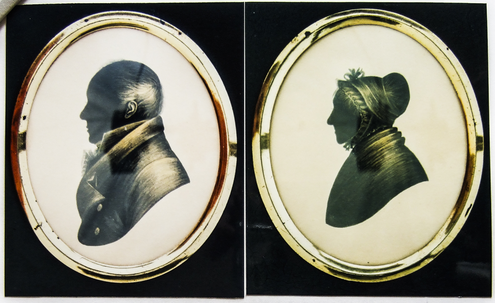
Both with labels and both from a Collection. Apologies for the quality of these photographs.
Attribution. Jeffreson is one of a small group of artists who used gilding over most of the body of his silhouettes to great effect. Others in this group include John Field, I. Hallam & E. Foster - Jeffreson has been likened to all these three artists in the literature. However, in my view apart from the fact that they all used extensive gilding I do not think serious collectors should be easily ‘confused'. Each had his own individual style and idiocyncratic touches. The golden work of J. Field is instantly recognised with few exceptions - it is very fine work and I think in a class of it's own. The gilded venetian red based work by Mr. Foster has it's own distinct style. I. Hallam's work is perhaps not so consistent and therefore possibly less easy to attribute with complete certainty without detailed knowledge of his use of gum arabic on the head of his 'sitters' and the shades of his gilding. Also, I do not think he was as skilled as Mr. Jeffreson.
His Work. This is entirely confined to bust-line silhouettes of the gilded variety. He is not known to have produced ungilded examples or full-length works of any kind. No conversation pieces have been associated with his name. He used a black base or a venetian red base - the former is the most common. The photographs in this article are all of silhouettes with a black base. I have only seen one silhouette with a venetian red base - this is of a man in the Victoria & Albert Collection. I have photocopied this
over/
Jeffreson cont’d.
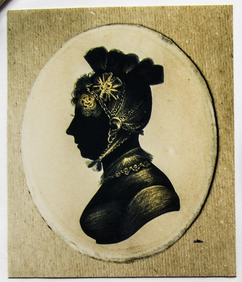
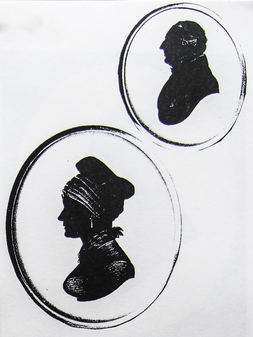 Two photocopies from the V. & A. Collection.
Two photocopies from the V. & A. Collection.
Lady on the left from the Joll Collection.
together with the black based silhouette of Mrs. Kingston also in that Collection. His style remains the same for either base colour. He used a machine to obtain an outline of the profile. I have photographed a rudimentary drawing that I found behind one of his silhouettes - which illustrates this.
Literature. Mrs. McKechnie has two entries on Mr. Jeffreson :- Section I on Cut-outs and Section 2 on Painted work on card or paper. In Section I she does not illustrate any examples as she had not seen any - Mrs. Jackson had mentioned this type of work in her Dictionary. Mrs. McKechnie assumed if it existed it would be gilded in the same way as his painted work. In Section 2 (her main entry) she has 9 illustrations - 7 of bust-line silhouettes and two of labels. Mr. J.Woodiwiss has an entry on Mr. Jeffreson in his book "British Silhouettes" (published in 1968). This refers to the artist as "bombastic and less efficient type of scissor worker .... who splashed gold paint with lavish abandon…” I think this comment is not fair to Mr. Jeffreson's work and unusual one for Mr. Woodiwiss to make. It seems that he made an assumption that all Mr. Jeffreson's work was cut and not painted. Otherwise there is very little written on Mr. Jeffreson by other writers on the subject of silhouette.
over/
Jeffreson cont’d.
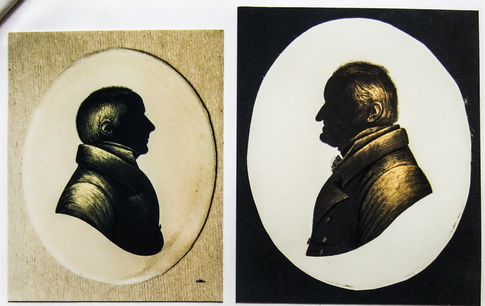
Both men without labels but sold with a Jeffreson lady.The man on the right has been cleaned.
Bust-lines. As Mrs. McKechnie points out these vary - although there seems to be more consistency as far as his women are concerned. All the busts of the women seem to be shallower than those of the men, but a number that are well recorded have a little 'indentation' or 'shelf' just below the bust of the sitters. I have photographed three of these - my modest bonnetted lady and the lady from the Andrew's Collection at Stoner House (both on the first page of this article) and finally my elaborately bonnetted lady. The majority of Mrs. McKechnie's illustrations of women show this 'shelf' (which is 'diagnostic' when it occurs). However, she has two illustrations that do not show this characteristic (page 489 nos. 854 & 855), but are never-the-less rounded-off to create the same basic bust-line shape. The photograph of the elderly lady from the Collection illustrates this well. On the other hand bust-line terminations on the men are less easy to recognise - being of the more usual sloping type adopted by a number of artists of this period. I have photographed three men in this article (1 labelled and 2 not - although both were bought in the same lot as an obviously Jeffreson lady), I am sure that they are bath by Mr. Jeffreson - but let me know if you disagree!
Gilding. The colour of Jeffreson's gilding is difficult to show as photography plays ‘tricks! His gold is a true gold and not bronzy in any way and certainly not with a yellowish tinge. In some of the photographs the gold is rather
over/
JEFFRESON Cont'd.
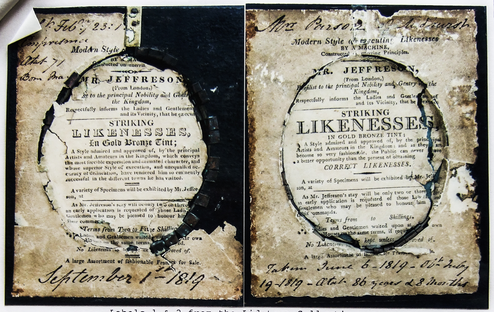
Labels 1 & 2 from the Lidstone Collection.
too pale and emphasises the blacker parts of the silhouette. His gold could be said to be on the 'warm' side. Generally his gilding is of a high quality - this can be shown in the lady from the Andrews' Collection and several others I have photographed. He uses fine lines in a skillful way. He is fairly consistent, although I think that my modest bonnetted lady at the beginning of this article leaves a little to be desired - perhaps she did not inspire him! The gilding covers most of the silhouette except the "parts in deepest shadow". Details of dress, hair and ears are well drawn - often eyebrows as well as eyelashes are shown. Mrs. McKechnie compares the quality of his gilding with that of J. Field - I am not certain that I would go as far as this. Perhaps Jeffreson at his very best is comparable.
Gum arabic. Mrs. McKechnie states that she has not seen any examples by Mr. Jeffreson using gum arabic. Since this was written labelled works by the artist have been seen where gum arabic has been used - in some instances quite extensively to emphasise details of clothing (including the headress) and to show the arm as distinct from the main body of the silhouette. The man from the Collection has gum arabic - also the elaborately bonnetted lady belonging to myself. Sometimes the gum arabic has not been mixed with colour -on other occasions this has been blackened to give greater emphasise. Clearly he did not always use gum arabic - some works are without any sign of it.
over/
JEFFRESON cont’d.
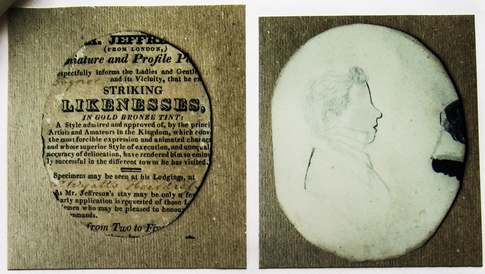
Label 4 from another Collection. Drawing on the right found behind a Jeffreson silhouette.
Labels. Two labels are known (labels 1 & 2) - these are very similar in wording but with some differences after "IN GOLD BRONZE TINT". Mrs. McKechnie mentioned a third label (label 3) found on a miniature recorded by Mrs. Jackson giving an address (4, New Street, Strand, London) - she had not seen it and there is no record of a miniaturist called Jeffreson. It is likely that this label has nothing to do with our Mr. Jeffreson. Also the address on the label was no help in throwing any more light on Mr. Jeffreson and his movements. Recently I have 'found' another label, which I shall call label 4. It is on the back of my modest bonnetted lady. It has similar wording to labels 1 & 2 but somewhat less boastful in tone! All labels that we know about have left spaces for the name of the town Jeffreson was visiting and the addresses of the houses/shops where he was leaving examples of his work. From the extant labels he is known to have visited Canterbury, Midhurst, Bognor and Lymington. No doubt he visited other places but not infrequently he left the spaces blank!
Frames. Works by Jeffreson are generally to be found in papier mache frames with emblem hangers.







